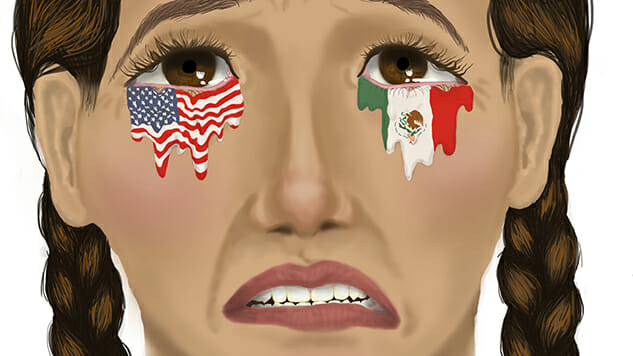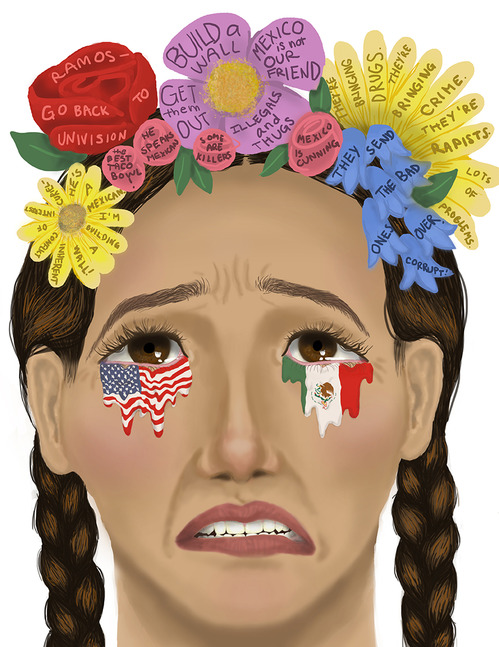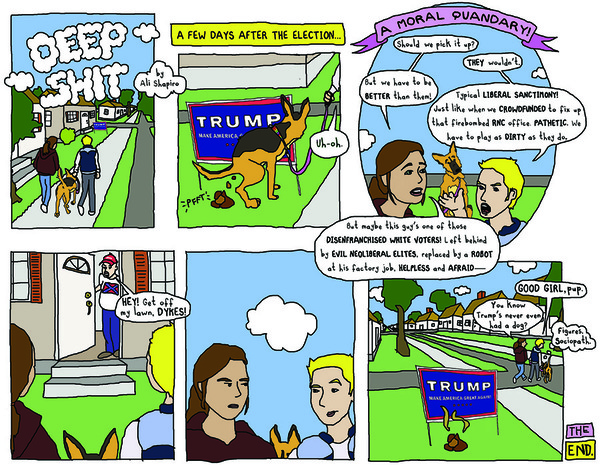Françoise Mouly & Nadja Spiegelman on RESIST!, the Women’s Rights Graphic Newspaper Released Last Weekend
Main Art by Ciena Valenzuela-Peterson Comics Features Françoise Mouly
Over the weekend, millions of women united throughout the country to protest the inauguration of President Donald Trump. From Anchorage, Alaska to Austin, Texas, hundreds of marches and demonstrations erupted across the country in what is being called the largest protest of an inauguration in American history. Showing solidarity with their American friends, family members and fellow human beings, men and women around the world took similar action—with sizable events popping up in France, England and Australia (and even a small protest in Antarctica). Over 2.5 million people came out in more than 600 different Sister Marches—local showings of solidarity with the Washington Women’s March.
At this gathering in the nation’s capital, over 30,000 copies of RESIST! were handed out. Published as a special edition of the newsprint, tabloid-sized Smoke Signal, the arts anthology features illustrations and comics from women all around the world, unified under the common theme of resisting fascism, bigotry and injustice in all its forms. The editors of the project—New Yorker art director Françoise Mouly and writer Nadja Spiegelman—were kind enough to sit down with Paste before the events of last weekend to discuss where the project came from and what they hoped it may accomplish. ![]()
Paste: Can you tell me a little bit about the project?
Françoise Mouly: It comes from Gabe Fowler, the owner of Desert Island Comics in Williamsburg, Brooklyn, who has published a tabloid called Smoke Signal for years now, which is something that he edits. It’s an old-fashioned tabloid of a size that hasn’t been seen since the underground comix. He got in touch with me right after the election, saying he wanted the next issue of Smoke Signal to be distributed at the [Women’s] March in Washington representing women’s voices. He wanted me as an editor. I mentioned it to Nadja—she’s a writer, and we’ve been working together. She jumped at the chance. So it started out as a blank check from Gabe, saying do it whichever way you want and I’ll bankroll it, distribute it. If I had been on my own, I probably would’ve contacted cartoonists and done it the old fashioned way. With Nadja, as I was doing that, we simultaneously put out an open call…
Nadja Spiegelman: It hit a nerve. The post we put on our social media went viral instantly. I think the combination of having an open call over the internet, where anyone can send something in and then have it be turned into something physical, like a newspaper, that would be handed out for free… That desire to contribute to some kind of concrete act was so powerful for people when they felt so hopeless.
Mouly: That [idea to hand RESIST! out at the march] was [Gabe Fowler’s] initial idea, and it was one of the reasons that put the whole thing into motion. I think it was why [the project] hit a nerve. It provided a deadline, and it provided a concrete action. It wasn’t just screaming into the wild. It was actually making a physical object. I think if it had been a curated slideshow on a website, it wouldn’t have been as entrancing. But making a permanent record of what we were feeling in this moment of impermanence…
Spiegelman: I think the fact that it’s free…we received so many submissions not only from artists, but an outpouring of people who wanted to donate money, who wanted to help us distribute it. It’s amazing to use the internet to create this community, grassroots movement that involves people going and handing others things physically and having an interaction. I’ve been so moved by the amount of support the project has gotten.

RESIST! Interior art by Ciena Valenzuela-Peterson
Paste: What steps, if any, did you take to make sure certain groups of women’s voices—whether it’s women of color, Muslim women, lower-income women—were represented in this collection?
Spiegelman: I would say that, for me, more than with most projects, diversity was a priority and one of the values that I was looking for in the work. We were hearing such a strong collective voice from the thousands of submissions that came in, but in order to translate that as clearly as possible, we needed it to be as multi-layered as possible. And I think what makes our newspaper of resistance is for it to be diverse.
Mouly: The quantity of work that was sent to us, the goodwill, the sheer number—because of how open it was, because there was no entry fee, people could send us as many images. We made those decisions the first day, that we weren’t going to limit anything. It let people take chances. And one thing we saw: we were posting work on the website, and it encouraged more. The more pieces of work we were posting, the more individual pieces came in.
Spiegelman: In the beginning, a lot more men than women were sending us images. But when we started posting only images by women on our website, a lot more women started sending us images, seeing that this was really a space for women to speak. And when women speak individually, they carry the pressure to speak for all women. But when they know they’re speaking as a group, they are able to speak for themselves, and so many of these women were speaking not as women, but as everything else that they were—as mothers, as Midwesterners, as librarians; as black or as immigrants or as trans. And that was what was so beautiful about getting those submissions together—that collective voice.
Mouly: We learned as we went along, and the process scripted itself, by the sheer number of submissions and by what we were showing. At first we got a lot of submissions that echoed each other, like “When I woke up that morning, I didn’t even know where to go…” But once that had been said, people had to go deeper into their personal experiences, and because we encouraged more comics—at first we had more political cartoons or graphics—we had people who weren’t necessarily professional cartoonists sending us things. And that was what was so exciting, that you could see people using the medium.
I remember Tits & Clits Comix, Wimmen’s Comix, Aline Kominsky. This is kind of like the new generation’s version of Wimmen’s Comix done in a way that, I think, is not just catching up with what’s going on, but is at the leading edge of the culture right now. In part, because our message is not a denunciation of Trump; it’s an affirmation of the diverse realities that have been denied by the Trump campaign. The Trump campaign is only present by the fact that it has been xenophobic, racist, as well as sexist. He didn’t succeed in spite of the fact that he wanted to expel all the Muslims and illegal aliens; he has been successful because he espoused messages of dismissal. So he creates a need to spell out what you stand for. And I am grateful to him, because he is responsible for people—certainly everyone who contributed something to RESIST!—getting committed or recommitted to not take for granted what is important to them.

RESIST! Interior art by Ali Shapiro
Paste: Would you say that putting out the open call and being able to put work up online was suited to representing a more comprehensive picture of American women? And then more generally, that the internet has been beneficial to revealing that women are making comics, women are reading comics in higher numbers than maybe some people were aware of?
Spiegelman: I think the internet can give a false sense that you’re reaching everyone. Our call for open submissions went viral on our social media, but as we all know, that’s a self-reinforcing bubble of who you know, so it does have some self-limiting qualities to how far it can actually go. So I went out of my way to also contact various groups of artists of color to send them the link.
Mouly: One of the ways that [RESIST!] is diverse is that we got contributions from around the world. Only the internet would allow you to do this. You couldn’t get that kind of a response if you were asking people to mail things, so there is a democratic quality to the internet. But for us, what was really exciting is the community, the support, people commenting on [each other’s work] and encouraging each other. On Facebook for example, you could see people sending it to their friends who are artists. So the kind of Hey, look at this! Look at this! Look at this! did feel very genuine in a way that was very exciting for us. The opportunity [to contribute] was given to everybody; we have young kids, teachers that assigned it to their students—
Spiegelman: We have at least two women from Australia in the newspaper.
Mouly: What was really exciting to me was that it wasn’t all professional artists. It’s really hard in my position to break out of that circle; at The New Yorker, I get unsolicited submissions, but [RESIST!] is filled with people I didn’t know. I discovered so much, and the energy is in parallel. When I showed it to a colleague of mine who is also an art director, they got extremely excited, because stylistically it’s all over the place. It’s people who can’t draw as well, it’s people who are masterful. It reconnects you to a raw energy. And the magic of it is that back and forth on a printed paper that is being given out. Like Nadja was saying, if that was like Illustration Annual and we were trying to sell a $30, glossy copy of a book, we could label it as exciting, but it wouldn’t have the same excitement. But the fact that we’re going to be standing on street corners, and the artists are going to be giving away their work, printed, with the work of other artists—this is a hopeful gesture in this day and age.
Spiegelman: I think people also critique the internet as being a way for people to feel like they’re being activists by signing an online petition, or clicking to donate $5, but we also have people who signed up to receive shipments of 5,000 copies and organize widespread distribution in the Northwest or in Chicago. We have hundreds of people who wanted to meet in person to hand things out.

RESIST! Interior art by Ghazaleh Rastgar
Paste: You’ve both talked about the effect that this project has had—this subject, this opportunity, the space it provides—and so I was curious what both of you think the political role of art can be. Is it just some way to express yourself, or is it a way to organize collective action, or is it something else entirely?
Mouly: One of the things we’ve been very happy about is that there’s no ambiguity in our paper. One of the journalists who interviewed us about RESIST! is a freelancer; he’s going to the march, he totally gets what we’re doing, but his news organization accepted the article on RESIST! on the condition that he also finds the equivalent on the Trump side. So he had to, and he found someone who is doing pro-Trump artwork, so his piece is going to be balanced. On one end there will be RESIST! and on the other there’ll be this guy who thinks Trump is the greatest thing on earth. And that’s exactly what we feel is our place. RESIST! is not balanced, it is not giving equal voice to people who were waking up on November 9th delighted that Trump was elected.
Spiegelman: Thank god no one sent us anything that was pro-Trump.
Mouly: No, nobody did. And we made sure that that wasn’t the pretense, that we were objective journalists. And I think part of it is my background. I grew up in France, I grew up with Charlie Hebdo and Hara-Kiri, and a French press that calls its color: if you’re from the Right, you say you’re from the Right, and that’s how you present your paper. So there’s no paper that’s equanimous or that pretends to represent everyone. I think that’s an absurd conceit, and it serves the conservative view very well to pretend that the only way to do journalism is to present the for and the against. It creates a staid middle ground. For example, in this other journalist’s piece, there will be this pretense that there’s an equal desire for pro-Trump art. And the truth is: there’s not! I haven’t seen an explosion of pro-Trump art. Most of the pro-Trump support is in the form of verbal abuse.
Spiegelman: Even at Trump’s inauguration there are very few artists who want to play. And there’s so much art happening, writing happening that is on the liberal side of things right now. And I think that’s because art can be dangerous in its ability to empower, its ability to give individual voice to minorities, its ability to cut through hypocrisy and to mobilize.